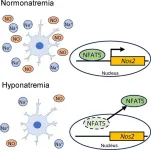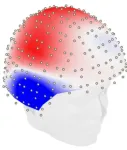(Press-News.org) Metal exposure from environmental pollution is associated with increased calcium buildup in the coronary arteries at a level comparable to traditional risk factors like smoking and diabetes, according to a study published today in JACC, the flagship journal of the American College of Cardiology. The findings support that metals in the body are associated with the progression of plaque buildup in the arteries and potentially provide a new strategy for managing and preventing atherosclerosis.
"Our findings highlight the importance of considering metal exposure as a significant risk factor for atherosclerosis and CVD," said Katlyn E. McGraw, PhD, a postdoctoral research scientist at Columbia University Mailman School of Public Health and lead author of the study. "This could lead to new prevention and treatment strategies that target metal exposure."
Atherosclerosis is a condition in which the arteries become narrowed and hardened due to a buildup of plaque. This can restrict blood flow and cause clots to form. It’s an underlying cause of heart attacks, strokes, and peripheral artery disease (PAD), the most common forms of cardiovascular disease (CVD). Atherosclerosis causes coronary artery calcium (CAC), which can be measured non-invasively to predict future cardiac events.
"This groundbreaking study underscores the critical associations of metal exposure from environmental pollution to cardiovascular health,” said Harlan M. Krumholz, the Harold H. Hines, Jr. Professor at Yale and Editor-in-Chief of JACC. “It challenges us to broaden our approach to CVD prevention beyond traditional risk factors and to advocate for stronger environmental regulations, and it underscores the need for continued research in this critical area."
Exposure to environmental pollutants like metals is a newly recognized risk factor for CVD, but there isn’t a lot of research on its association with CAC. Researchers in this study sought to determine how urinary metal levels, biomarkers of metal exposure and internal doses of metals impact CAC.
Researchers used data from the Multi-Ethnic Study of Atherosclerosis (MESA) prospective cohort, tracking 6,418 men and women aged 45-84 from diverse racial backgrounds free from clinical CVD, to measure urinary metal levels at the beginning of the study in 2000-2002. They examined non-essential (cadmium, tungsten, uranium) and essential (cobalt, copper, zinc) metals, both common in U.S. populations and associated with CVD. Widespread cadmium, tungsten, uranium, cobalt, copper, and zinc pollution occurs from agricultural and industrial uses such as fertilizers, batteries, oil production, welding, mining, and nuclear energy production. Tobacco smoke is the main source of cadmium exposure.
Results provided evidence that metal exposure may be associated with atherosclerosis over 10 years by increasing coronary calcification.
Comparing the highest to lowest quartile of urinary cadmium, CAC levels were 51% higher at baseline and 75% higher over the 10-year period. For urinary tungsten, uranium and cobalt, the corresponding CAC levels over the 10-year period were 45%, 39%, and 47% higher, respectively. For copper and zinc, the corresponding estimates dropped from 55% to 33% and from 85% to 57%, respectively, after adjustment for clinical factors.
Non-essential and essential urinary metal levels also varied by demographic characteristics. Higher urinary metal levels were seen in older participants, Chinese participants and those with less education. Participants from Los Angeles had markedly higher urinary tungsten and uranium levels, and somewhat higher cadmium, cobalt, and copper levels.
The study's analysis also considered traditional CVD risk factors such as smoking, diabetes, and LDL-cholesterol levels. The associations between metals and CAC progression were comparable in magnitude to those for traditional risk factors.
“Pollution is the greatest environmental risk to cardiovascular health,” McGraw said. “Given the widespread occurrence of these metals due to industrial and agricultural activities, this study calls for heightened awareness and regulatory measures to limit exposure and protect cardiovascular health.”
Limitations of the study include the unavailability of plaque transition measures in MESA, changes in exposure sources and other factors causing variability of certain measured metals, and the potential for residual and unknown confounding of time-varying exposure measurements.
In an accompanying editorial comment, Sadeer Al-Kindi, MD, Associate Director of Cardiovascular Prevention and Wellness at the Houston Methodist DeBakey Heart and Vascular Center, said the evidence of the study has important implications for public health, health equity and clinical practice.
“The field of environmental cardiovascular medicine, exemplified by this research, offers an emerging frontier in cardiovascular disease prevention and treatment,” Al-Kindi said. “Addressing environmental risk factors like metal exposure will significantly reduce the global burden of cardiovascular disease and address long-standing health disparities.”
The American College of Cardiology (ACC) is the global leader in transforming cardiovascular care and improving heart health for all. As the preeminent source of professional medical education for the entire cardiovascular care team since 1949, ACC credentials cardiovascular professionals in over 140 countries who meet stringent qualifications and leads in the formation of health policy, standards and guidelines. Through its world-renowned family of JACC Journals, NCDR registries, ACC Accreditation Services, global network of Member Sections, CardioSmart patient resources and more, the College is committed to ensuring a world where science, knowledge and innovation optimize patient care and outcomes. Learn more at www.ACC.org or follow @ACCinTouch.
The ACC’s JACC Journals rank among the top cardiovascular journals in the world for scientific impact. The flagship journal, the Journal of the American College of Cardiology (JACC) — and specialty journals consisting of JACC: Advances, JACC: Asia, JACC: Basic to Translational Science, JACC: CardioOncology, JACC: Cardiovascular Imaging, JACC: Cardiovascular Interventions, JACC: Case Reports, JACC: Clinical Electrophysiology and JACC: Heart Failure — pride themselves on publishing the top peer-reviewed research on all aspects of cardiovascular disease. Learn more at JACC.org.
###
END
New therapeutic opportunities often emerge from research on simple organisms. For instance, the 2020 Nobel Prize in Chemistry awarded to Emmanuelle Charpentier, Ph.D., and Jennifer Doudna, Ph.D., for their CRISPR-based DNA editing discovery began with studies using bacteria just a decade prior. Today, CRISPR therapies are approved for several disorders, and more such treatments are in the offing.
Recognizing the translational potential of studies in simpler animal models, a team of scientists led by Randy D. Blakely, ...
LOS ANGELES — Keck Hospital of USC has been named a top performer in the 2024 Bernard A. Birnbaum, MD, Quality Leadership award by Vizient, Inc., a leading health care performance improvement company.
The top performer designation acknowledges the hospital’s excellence in delivering high-quality care as measured by the annual Vizient Quality and Accountability Study.
Keck Hospital was among 14 top performers out of 115 comprehensive academic medical centers nationally and achieved a five-star ...
Note: Embargoed until 8:00 a.m. ET on Sept. 18, 2024
From the early telescopes made hundreds of years ago by Galileo to the sophisticated astronomical observatories of today, people have built increasingly innovative tools to probe and measure the cosmos. Soon, researchers at two new institutes funded by the U.S. National Science Foundation and the Simons Foundation will build a new breed of astronomical tools by harnessing the uniquely powerful abilities of artificial intelligence to assist and accelerate humanity's understanding of the universe.
The new National Artificial Intelligence ...
Low serum sodium concentrations in blood are called hyponatremia, a prevalent clinical electrolyte disorder. In contrast to acute hyponatremia, chronic hyponatremia has been previously considered asymptomatic because the brain can successfully adapt to hyponatremia. If not treated, chronic hyponatremia can lead to complications such as fractures, falls, memory impairment, and other mental issues. Treating the chronic condition is, however, quite tricky as it has been observed that overly rapid correction of hyponatremia ...
EMBARGOED by Alzheimer’s & Dementia until 7 a.m., ET, Sept. 18, 2024
Contact: Gina DiGravio, Boston University, 617-358-7838, ginad@bu.edu
Contact: Andrea Zeek, IU School of Medicine, 317-671-3114, anzeek@iu.edu
(Boston)— The failure to diagnose Alzheimer’s disease, the most common form of dementia in the elderly, at an early stage of molecular pathology is considered a major reason why treatments fail in clinical trials. Previous research to molecularly diagnose Alzheimer’s disease yielded "A/T/N" central biomarkers based on the measurements of proteins, β-amyloid (“A”) and tau (“T”), ...
About The Study: In this study, a higher burden of comorbidity was associated with worse clinical outcomes in people with multiple sclerosis (MS), although comorbidity could potentially be a partial mediator of other negative prognostic factors. The findings suggest a substantial adverse association of the comorbidities investigated with MS disease activity and that prevention and management of comorbidities should be a pressing concern in clinical practice.
Corresponding Author: To contact the corresponding author, Amber Salter, PhD, email amber.salter@utsouthwestern.edu.
To access the embargoed study: Visit our For The Media website at this ...
London, United Kingdom, 18 September 2024 – UK Research and Innovation (UKRI), the UK’s largest public funder of research, has confirmed funding for a new phase of the DARE UK (Data and Analytics Research Environments UK) programme with up to £18.2 million made available over 2.5 years.
Starting this month, Phase 2 of the DARE UK programme will bring together Trusted Research Environments (TREs) across the UK to test and build new capabilities for a connected national network of secure data ...
The type 1 ryanodine receptor (RyR1) is an important calcium release channel in skeletal muscles essential for muscle contraction. It mediates calcium release from the sarcoplasmic reticulum, a calcium-storing organelle in muscle cells, a process vital for muscle function. Mutations in the RyR1 gene can affect the channel's function in extremely contrasting ways leading to severe muscle diseases such as malignant hyperthermia (MH) and central core disease (CCD). MH is an inherited disease that causes high fever and muscle contractures in response to inhalational anesthetics in patients with gain-of-function RyR1 variants. CCD is one ...
Millions of birds migrate every year to escape winter, but spending time in a warmer climate does not save them energy, according to research by the Max Planck Institute of Animal Behavior (MPI-AB). Using miniaturized loggers implanted in wild blackbirds, scientists recorded detailed measurements of heart rate and body temperature from birds every 30 minutes from fall to the following spring—the first time the physiology of free flying birds has been quantified continuously at this scale over the entire wintering period. The data offer unprecedented insights into the true energetic costs of migrant and resident strategies and reveal a previously unknown mechanism used by migrants to ...
Amyloid-beta and tau proteins have long been associated with Alzheimer’s disease. The pathological buildup of these proteins leads to cognitive decline in people with the disease. How it does that, though, remains poorly understood.
A new study from the labs of Sylvain Baillet at The Neuro and Sylvia Villeneuve at the Douglas Research Centre provides important insight into how these proteins impact brain activity and possibly contribute to cognitive decline.
The team led by Jonathan Gallego Rudolf, a Ph.D. candidate in Baillet and Villeneuve’s ...






